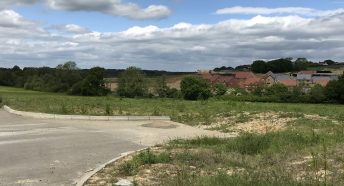Michael Brown writes about the Planning for the Future White Paper
Michael Brown, CPRE Sussex, explains what’s in the White Paper, what it means for us in Sussex and what you can do about it.
Introduction. You may well have heard that, along with everything else that is going on, the Government is proposing to tear up and re-write the planning system rulebook. They argue that the current system isn’t getting enough houses built, is too slow at getting them built, and too old-fashioned; and that only radical changes will solve these problems. Their purpose is, in the Prime Minister’s words to “build, build, build”.
You may also have heard that these reform proposals have met extremely widespread opposition from across the spectrum of those involved in the planning system; in fact almost everyone except developers – who will benefit hugely from Local Government Minister Robert Jenrick’s reforms – and their advisers.
The intended changes are manifold and far-reaching. But too many of them don’t stand scrutiny and are positively harmful.
Too few houses? Whilst the Government is not only sticking to its determination to see 300,000 new homes built each year, and is indeed upping that expectation to 337,000 p.a., it’s own figures provided by the Office of National Statistics project a declining need for new housing – on data released by the ONS this year the annual need has gone down to [207,000] p.a.
But rather than ask local planning authorities (LPAs) to revise their housing targets to recognise this changing reality, the Government intends to strip local authorities of their responsibility to set their plan targets by reference to locally assessed need, and to impose a new target on them, set by central Government based on their overall arbitrary 337,000 new homes assessment.
And, in the land that produced the school exam results algorithm and the world beating Covid 19 test and tracing app, the Government will work out what each LPA’s target should be using another new algorithm. Does that fill you with confidence? Nor should it. The algorithm relies on a series of false premises:
- It starts with the inflated assumption as to the number of houses we need to build;
- It assumes that, if we load the number of houses to be built in the already most crowded parts of the country – because that’s where they are most expensive – it will drive down house prices in those areas. All the evidence is that won’t happen: that developers only build houses at a rate that enables them to sell them without reducing their (high) profit margin;
- It imposes centrally an adjustment requiring LPAs to accept additional housing from nearby overcrowded areas without sufficient sensitivity to their ability to do so;
- It piles far more housing into rural areas than urban ones and, despite claims to the contrary, the algorithm appears to have scant regard to environmental and other constraints (such as areas of outstanding natural beauty and SSSIs) on rural areas’ ability to absorb new housing. We address below its radical impact within Sussex.
- By pressuring the most crowded areas to accept more housing with the infrastructure to support it, it denies help those parts of the country most in need of regeneration and of the infrastructure funding needed to make that possible.
There has already been sufficient outcry over these implications for hints to be given from on high that the algorithm may be tweaked. Take what comfort you may from that!
The right kind of homes? The new system fails miserably to focus new housing on the types of housing for which the need is greatest: in the social and affordable housing sector – housing for rent as well as (co)-ownership. The Government has been advised that there is a need to build 145,000 new affordable homes p.a. over the next decade with substantial long term funding support to get local authorities, Housing Associations etc back into the social housing business. But there is no suggestion that the Government will set an affordable new housing target, and a number of the new measures propose will reduce the level of private sector affordable housing provision.
Nor is it clear how (if at all) LPAs will be able to ensure that whatever houses that are built will be of the mix and in locations needed to meet local needs for different demographic groups, be they young people seeking to get onto the property ladder, older people needing medically-supported accommodation, or whatever.
Where are these new houses going to go? LPAs are going to lose their responsibility to locate the most suitable and sustainable sites. Instead their Local Plans will have to divide up their district into 3 zones: growth zones (“suitable for substantial development” where outline planning permission will be automatic”); renewal zones (areas “suitable for gentle densification” in which a presumption in favour of development and a less rigorous planning process, and a watered down definition of sustainability would apply) and protected zones (“restricted development” areas).
The Government claims that zoning systems used elsewhere in Europe result in speedier development). But the Government’s proposals involve a far blunter instrument than their continental peers, and leave little scope for detailed case by case consideration of the pros and cons of a given individual development proposal.
Is there a place for nature in these plans? The conservation of the countryside and its biodiversity gets short shrift in this drive to build, build, build. The Government wants to water down the already inadequate definition of sustainability in the planning rulebook. There will be no opportunity to zone areas for environmental restoration and, perhaps most worryingly of all, site specific environmental and landscape value assessments will go by the board.
Nor will protected zones be free of development threat. We are a little less concerned for national parks (which are separate planning authorities in their own right) than we are for AONBs and other areas carrying lesser designations such as sites of special scientific interest. With even higher housing targets in Sussex’s rural districts set through central Government’s algorithm, the pressure to build market housing in AONBs is going to be greater than ever.
Where do Local and Neighbourhood Plans fit in?
The idea is that future Local Plans will be shorter and, relieved of the burden of calculating their district’s local housing need, their main role will be to determine the boundaries of the new zones and what development should be allowed in each zone. Zoning decisions under the regime will be no less contentious than site allocation decisions under the current rules.
New Plans will have to be in place within a fixed 30 month period. Whilst the principle of speeding up the finalisation of local plans is welcome in principle, a 30 month start to finish timeframe is almost certainly unrealistic if zoning and other decisions are to be based on genuinely robust detailed evidence and with proper consultation.
They will also be encouraged to develop local good building design guides for new developments. Evidence of environmental, landscape and other impacts will be considered in the context of zoning decisions – undertaking site specific assessments at the time of development applications is considered to be too time-wasting.
The significance of neighbourhood plans will be further reduced with the removal of LPAs’ development management powers, and existing neighbourhood plans that have been produced by local parishes with so much energy and effort are liable to go more quickly out of date. Parishes will have a say in building design and layout but, seemingly, in little else. Communities fragile faith in the much touted localism agenda will be tested yet again and, in many instances may well be found wanting.
All LPAs will have to start their strategic planning again from scratch using the new system if and when it is introduced, and the status of existing Local and Neighbourhood Plans in the interim period will be uncertain. A period of considerable upheaval and uncertain is inevitable.
The Government is extremely keen to introduce digital technology into the local and neighbourhood planning process and require new digital tools to be used for the development of plans. The Government doesn’t have a good track record with new technology, and the White Paper advocating the changes is disturbingly full of techno-babble. So how well it will work, and how those who are technologically challenged will engage, remains to be seen.
Where does the money come from? LPAs will lose their power to subsidise local infrastructure improvements through the Community Infrastructure Levy or so called s106 agreements. That means that the normal requirement for developers to provide a proportion of affordable housing as a condition of planning approval for market housing will also disappear. In its place will come a new centrally run, flat rate, Infrastructure Levy (IL). There is no substantial information as to how the new IL will operate, how much money it will raise, how many new affordable homes it would fund, or how reliably local road or service improvements necessitated by individual developments (local school, surgery and library pressures, for example) will all be funded from this single central IL pot.
Will ordinary people and organisations like CPRE have a say in planning within their District? Of course they will, says the Government, and at an earlier stage, during the simplified Local Plan development, so they can influence the direction of travel. That reassurance needs to be treated with some scepticism:
- The algorithm-based key decision on how many houses each District must build will be imposed by central Government, and completely excludes the views of those who live there in order to save planning time;
- The voice of the people is seemingly not wanted on the impacts of individual developments on a community and its local environment because it would slow down the housebuilding process once the zones are settled;
- Those who are not technologically savvy will struggle to contribute: input will be expected to occur through “digital neighbourhood groups” as these “will make it radically easier to raise views about and visualise emerging proposals whilst on-the-go on a smart phone”;
- There is a risk that the core role of localism through neighbourhood planning other than as a (digital) forum to discuss design impacts will wither on the vine.
What does this mean for us in Sussex?
Because Sussex is a popular county to live in, and move into, we will get a lot more houses than are currently planned for. We will have no say at all in how many houses and business units get built, district by district, in Sussex, and less input in where they will go within the District. We will have more say in what they look like.
The Government algorithm determining district housing targets, as it stands, will reduce Brighton & Hove’s housing requirement (logical since it lacks the space to meet its full need); but produce radical increases in the housing targets for all Sussex’s rural districts. To take one local example, 83% of rural Rother district lies within the High Weald AONB, but it would be expected to increase the number of houses built from its current Local Plan target of 335 p.a. to 1,173 p.a. (Yes, you read that right!). Horsham will be almost as badly overwhelmed. Other rural districts in Sussex, all of them environmentally constrained to a greater or lesser degree, would see whopping increases in their imposed targets. The changes for each Sussex district are shown on the table at the end of this letter.
We simply don’t know how the new zoning system would work in practice, or the level of detail that LPAs would be able introduce into it in order to protect individual small but precious pockets of green. But we are very fearful that the new system will give LPAs and residents far less control over the most appropriate, sustainable planning for their areas, and that our already pressured countryside and its biodiversity will be relegated to playing second or third fiddle to the drive for new development. Environmental conservation and improvement is little more than a token afterthought in the new planning proposals.
Our smaller towns and villages often need limited additional housing, especially the right mix of affordable homes for local people providing essential local services, and for their families. But they don’t need ‘gentle densification’ of lots of 4 and 5 bedroom market homes built on out of town greenfield sites. And it is pie in the sky to believe that building lots more of that kind of housing will bring local house prices down: the developers have a vested interest in ensuring that does not happen.
One of the Government’s proposals is to raise the threshold below which new developments must include a proportion (usually 30%) of affordable homes from 10 home sites to 40 or 50 home sites, thereby reducing considerably the number of affordable homes that will be delivered through Local Plans – directly in opposition to the national priority need for more affordable and social housing. In Mid Sussex, for example, in 2019/20 only 9% of the 211 residential applications were on sites above 40 units. Where, oh where, is the wisdom in that?
The county is rich in undesignated, but often wonderful countryside. Housing target pressures will make much of it vulnerable to zoning as “renewal zone”, thereby putting its green fields, its wildlife and biodiversity at increased risk.
Even so-called protected zones such as the High Weald AONB, where planning rules say that new development will continue to be restricted, will become far more exposed to major development. Since the last major planning reforms in 2012, the High Weald has already experienced the highest rate of new housing growth of any of England’s 34 AONBs. With Sussex’s rural LPAs being told to increase their housing targets so dramatically (and punished if they fail to deliver), the pressure to use our two AONBs as a new housing resource will be greater than ever. So much for these areas enjoying “the highest status of protection” from new development, as the National Planning Performance Framework reassures us!
If the planning laws have to be changed it is a great pity that the Government is not taking the opportunity to base their new proposals on good evidence of what changes are needed and will work; in particular that they are not either focusing their attention on the real crisis in the supply of affordable and social housing; nor taking the opportunity to invest in the regeneration of areas with poor infrastructure and outdated housing rather than adding to the pressures in the already overheated south east of England. As it is the proposals can be summed up in two short, simple Anglo-Saxon words: ideological iconoclasm.
What’s to be done about it? As you would expect, CPRE will be making forceful representations to Government about these changes and their impacts, and has already met directly with the relevant Minister, Robert Jenrick MP. We are collaborating with other like-minded organisations across the planning spectrum who share our concerns. You can keep up to date with what we are doing, both locally and nationally, on our websites: www.cpresussex.org.uk and www.cpre.org.uk.
We are also writing to local MPs, who may not all have been aware of the effects that these mooted changes will have on their constituents. Some of our MPs have already come out as very concerned about the Government’s proposals. We hope that ordinary MPs will be sufficiently concerned to seek to influence Government thinking on these ill-informed, far-reaching, radical proposals.
Whatever your own views, if you would like to make your voice heard, please do write direct to your own local MP. You can also respond to the White Paper consultation document (view it at https://www.gov.uk/government/consultations/planning-for-the-future). The consultation period for that document ends on Thursday 29 October.
Michael Brown
26 September 2020





